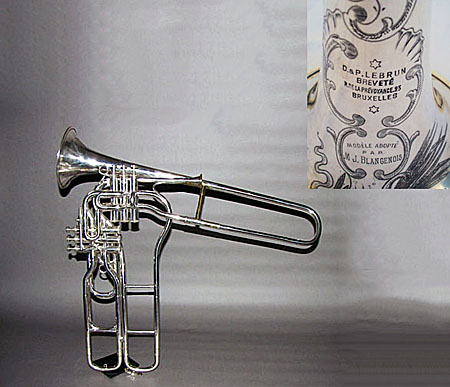
Owner: HWMC
Catalog#: CL-AELV-163
Trombones / Sackbuts
‘D & P Lebrun’ Trombone - 6 Valves
Brussels, Belgium
D & P Lebrun
Metal
ca. 1920’s
Bell Length: 26.3 in, Bell Diameter: 6.3 in
Wind Instruments – Brass Instruments – Trombones / Sackbuts
Engraving on bell: “D&P LEBRUN / BREVETE / Rue de la Prévoyance 23 / BRUXELLES / Modèle adopté / par / M.J. BLANGENOIS.”
The valves are stamped: “D&P LEBRUN BRUXELLES” on the 2d and 4th valves and “1-2-3-4-5-6” on the tops and bottoms of the valves
Each valve of this rare Désiré and Pierre Lebrun six independent-valve, calvary-style trombone in Bb, is pressed independently (not in combination) and can be compared to the 7-positions of a slide trombone. The idea being that each note can be tuned independently since each valve has its own slide for tuning. The Lebrun company were specialists of the valve trombones and perfected Adolphe Sax’s invention. The firm was active at Rue de la Prévoyance 23, between 1914 and 1923. Jules Blangenois (engraved on bell) was a composer, trombonist and teacher, born in Tournai, Belgium, on April 28, 1870, and died in Brussels on July 29th 1957.
Adoph Sax’s system of six independent valves was devised to correct the intonation problems of typical three-valve instruments, which can sound out of tune when valves are used in combination. Valve trombones were useful in situations where using a slide was awkward, such as while marching, riding a horse, or playing in a cramped orchestra pit.
The valve system used on this instrument is detailed in Sax’s 1859 patent (France, No. 39371). It is an ascending system, since the valves do not add extra tubing to the instrument’s length. Instead, each of them isolates different amounts of the instrument’s total tubing. Each valve is to be used on its own and causes the instrument to sound a half-tone lower than the previous valve. Sax applied his six-valve independent system mostly to saxhorns and trombones.
Also detailed in the 1859 patent is the valve venting system seen on this trombone. Instead of having a vent hole in the bottom of each valve cap as is usual, the casing of each valve has an external tube for venting. This was designed to make the instrument more durable. It permits air to escape when the valve is depressed (like a typical perforated valve cap) but prevents dust from entering the casing.
Despite these innovations and the quality of their construction, Sax’s six-valve instruments did not achieve lasting popularity. Players were reluctant to learn such a radically different fingering system and the instruments were much heavier to hold than conventional three-valve models.
